When you look at the night sky, you’re seeing light that has traveled from the past. This fall, the southwestern horizon features Mars and Saturn, lit by reflected sunlight that has taken 9 and 88 minutes, respectively, to reach Earth from their surfaces. The light from the bright-red star Antares in Scorpius has been traveling for 550 years, so it’s 550 light-years away. At a distance of about 1.3 light-seconds, the moon is right on our doorstep, while the invisible center of our Milky Way galaxy, located just west of the Teapot asterism in Sagittarius, is 26,000 light-years away.
Did you know that if you gaze up at a clear evening sky, you’re actually looking into the past? Even with the naked eye, you can see starlight that was emitted years — or even centuries — ago. And if you know where to look, you can see galaxies so far away that their light has been traveling since before humans walked the Earth. Add the magnifying power of a telescope, and you’ll journey to the time when dinosaurs lived. In this edition of Mobile Astronomy, we’ll travel the celestial and see ancient starlight with our own two eyes.
The speed of light
Starlight is the visible part of an electromagnetic spectrum of radiation that our eyes have evolved to detect. Beyond the visible range are radio waves, X-rays and infrared. In the vacuum of space, electromagnetic radiation travels at a speed of 186,282 miles per second (or 299,792 km/s), usually denoted with a “c.” Albert Einstein showed that the speed of light is the top speed possible in the universe. Because of this, light from distant objects takes a long time to reach our eyes.
Space is so vast that distances soon become cumbersome to convey using everyday units. To write out the distance in miles to a nearby galaxy, you would need 19 zeros! As such, astronomers have adopted the term “light-year” — the distance light travels in a vacuum in one year. It’s 5,878,625,541,248 miles (9,460,730,743,054 km), or almost 6 trillion miles (more than 9 trillion km)! See what I mean? [Einstein’s Theory of General Relativity Explained (Infographic) ]
We can measure the distance to closer objects using light-minutes and light-seconds. For example, if a person in Los Angeles could see it, the light from a lamp switched on in New York City would cross the country to arrive 13 milliseconds later, after traveling 0.013 light-seconds. Moonlight takes 1.3 seconds to reach us on the ground. During the Apollo missions, the radio signals experienced the same delay, causing two-way conversations to be choppy. The light from the sun takes about 8 minutes and 20 seconds to travel to Earth, so we can say that it’s 8.3 light-minutes away.
Our planetary neighbors are far, but not too far. Right now, Venus and Mars are about 10 light-minutes away from Earth. At times of superior conjunction, when Mars is on the far side of the sun, the Red Planet can be as many as 22 light-minutes away. The resulting 44-minute round-trip for radio signals presents serious challenges for future Mars explorers! We typically see Jupiter and Saturn as they were more than an hour ago. As a rule, using a telescope makes an object’s light brighter and its image larger, but it doesn’t shorten the light’s travel time at all.
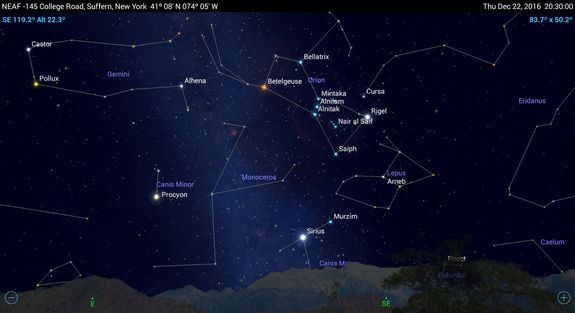
Winter brings another opportunity to see starlight from a range of eras. Sirius, the brightest star in the night sky, is only 8.6 light-years away. Meanwhile, the two brightest stars of Orion are distant but shine so brightly because they emit much more light. Betelgeuse is an old, red supergiant star 500 light-years away. It may already have exploded in a supernova blast, but we won’t know about it until the light arrives! Blue Rigel is about as bright as Betelgeuse but sits 860 light-years away
Credit: SkySafari App
Looking into the past
The stars we can see — besides the sun — are much farther away than the planets, but every one of them is still a “neighbor” in our Milky Way galaxy. You might think that the brightest stars in the sky are the closest ones, and sometimes that’s true. Vega , which shines overhead this month, is the fifth-brightest star in the heavens, and it’s only 25 light-years away. Even closer is the winter star Sirius , the brightest star in the nighttime sky. Its light has been traveling for only 8.6 years.
Using your favorite astronomy app, you can sample some very old starlight with your naked eyes. Looking north, the star Mizar — which marks the bend in the handle of the Big Dipper — is 85.8 light-years away. The light we see from Polaris tonight began its journey in 1586, when Shakespeare and Galileo were living. High in the eastern evening sky, the constellation Cygnus (the swan) includes two bright and distant stars. Deneb, at the great bird’s tail, is at least 1,550 light-years away. The light from the bright star Sadr, located only six degrees to the southwest, has traveled for approximately 1,800 years. These two stars are much more luminous than the sun, allowing them to shine so brightly even at those enormous distances.
If a celestial object is big enough, it can be much farther away and still be visible to the naked eye. The Wild Duck Cluster (also known as Messier 11) is a bright concentration of stars in one of the galaxy’s spiral arms that you can see with naked eyes under dark skies. Your sky charting app will point you to where it sits in the evening sky, about midway between the bright star Altair and Saturn. The cluster contains about 2,900 stars at a distance of more than 6,000 light-years! Use binoculars or a small telescope to get a better look. Use low magnification, though — it’s about one-third of the moon’s diameter across. [Stunning Photo Captures ‘Wild Duck’ Star Cluster in Flight ]
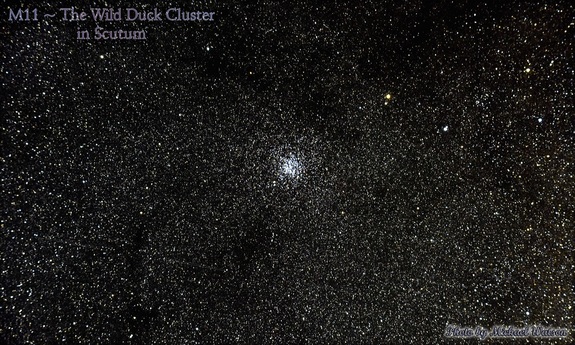
The Wild Duck Cluster, also known as Messier 11, is a popular target for stargazers in the summer and early fall. It’s a concentration of 2,900 stars that sits about 6,100 light-years away, in the plane of the galaxy. Search for it in your astronomy app. Then, using binoculars, hunt for a fuzzy patch in the star-filled region southwest of the constellation Aquila. Your telescope at low magnification will show it well. It’s approximately one-third of the moon’s diameter across. This image by Michael Watson of Toronto was taken in Algonquin Park using a Nikon D810 camera body on a 4-inch telescope.
Credit: Michael Watson , used with permission
Outside our neighborhood, there are globular star clusters — spherical concentrations of densely packed stars that orbit just outside our galaxy. The brightest one for skywatchers in North America is Messier 13, the Great Globular Cluster, located in the constellation Hercules . Its ancient, 23,000-year-old starlight appears as a dim, fuzzy patch to unaided eyes, and becomes a spectacular sight under magnification. Lucky observers in the Southern Hemisphere can also see Omega Centauri, the brightest globular cluster in the sky. At a “mere” 17,000 light-years away, it’s worth a trip south of the equator.
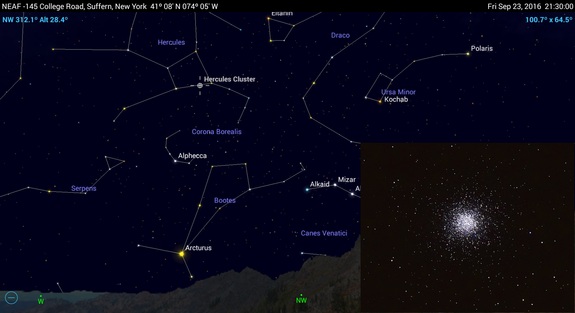
The Great Globular Cluster in the constellation Hercules, also known as Messier 13, is a dense, spherical collection of between several hundred thousand and 1 million stars. This one is visible to the naked eye under dark skies, and is readily seen in binoculars and small telescopes, even in urban areas. This cluster’s starlight is 23,000 years old. It’s one of many such objects scattered around the night sky. The inset image was taken by Michael Watson using a Nikon D810a camera body mounted on a 6-inch refracting telescope.
Credit: SkySafari App and Michael Watson , used with permission
Your astronomy app should list the distance to all of the prominent stars and deeper-sky objects. The SkySafari 5 search menu lets you search for the nearest or brightest star, as well as deep-sky objects, and includes the option to sort the lists and highlight the objects on the sky.
How far can you see?
Nearby galaxies are the farthest objects visible with unaided human eyes, and you can see them for yourself during the Northern Hemisphere’s fall and winter months. The Andromeda galaxy (Messier 31) is a large, spiral galaxy nicely placed in the eastern evening sky . It’s tilted obliquely in the sky so it forms a dim, elongated oval that brightens toward the core. A darker sky will show its true size — it’s more than six full moon diameters across! And here’s the amazing part: It is 2.5 million light-years away! When that light began its trip to Earth, Homo habilis (an early human species) was roaming Tanzania.
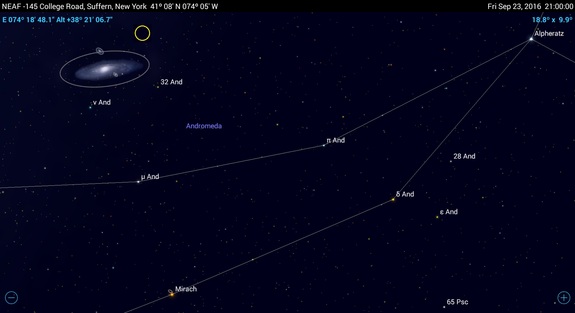
The light from the Andromeda galaxy (Messier 31) has been traveling for 2.5 million years, since Homo habilis roamed Tanzania. Look for an elongated, fuzzy patch just to the left (northeast) of the Great Square of Pegasus in the eastern evening sky. To the naked eye under dark skies, the bright core will be most apparent. It’s widely considered the most distant object you can directly see with your eyes. Binoculars or a small telescope can reveal that it is six moon diameters wide (as shown by the yellow circle).
Credit: SkySafari App
People have claimed to be able to see several other more distant galaxies under extremely dark skies, as well. Adding a telescope, you can see much further back in time. Here are a few suggestions for you to try with a backyard telescope. Your astronomy app will list many more. The objects with smaller visual magnitude values will be brighter and easier to see. None of them will appear very bright in the eyepiece, but you’ll be exploring the universe in space and time.
Messier 51 Spiral Galaxy in Canes Venatici magnitude 8.0 28 million light-years
Messier 84 Elliptical Galaxy in Virgo magnitude 9.0 67 million light-years
Messier 109 Spiral Galaxy in Ursa Major magnitude 9.7 82 million light-years
Going beyond
With a very large telescope, astronomers can reach deeper into the distant past, nearly to the beginning of time. Over the course of a decade, NASA directed the Hubble Space Telescope to image a small, seemingly empty patch of sky in the constellation Fornax. By accumulating more than 2 million seconds of exposure time, in visible and other wavelengths of light, the telescope captured a scene containing thousands of galaxies, some of which are so distant that their light shows as they existed 13.2 billion years ago — only 500 million years after the Big Bang. The image, known as the Hubble eXtreme Deep Field, is only the beginning of this exploration. Its successor, the James Webb Space Telescope — scheduled to launch in 2018 — should see hundreds of millions of years farther back than that!
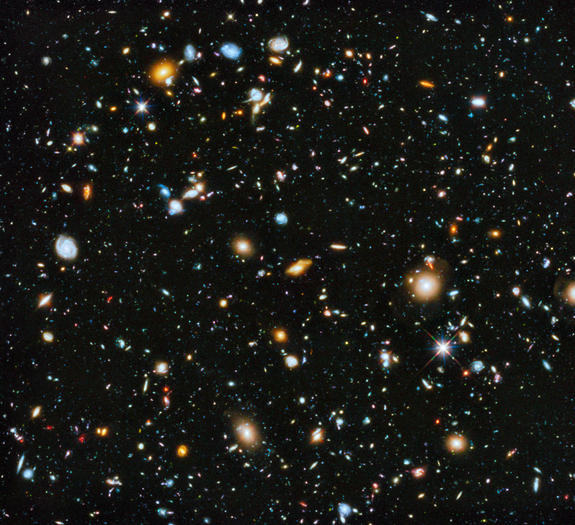
The Hubble Space Telescope accumulated approximately 555 hours of exposure time to capture this Hubble eXtreme Deep Field image. The area shown represents a seemingly empty patch of sky about the width of a toothpick when held at arm’s length. The picture contains only two foreground stars (indicated by surrounding spikes). Every other object is a galaxy. The most distant galaxies’ light is reddened by the expansion of the universe. We’re seeing light that left them 13.2 billion years ago.
Credit: NASA
In future mobile astronomy columns, we’ll look at how astronomers measure the distances to objects, review some new apps and gadgets, and more. Send me your suggestions! In the meantime, keep looking up!
Editor’s note: Chris Vaughan is an astronomy public outreach and education specialist, and operator of the historic 1.88-meter David Dunlap Observatory telescope. You can reach him via email, and follow him on Twitter as @astrogeoguy , as well as on Facebook and Tumblr .
This article was provided by Simulation Curriculum , the leader in space science curriculum solutions and the makers of the SkySafari app for Android and iOS. Follow SkySafari on Twitter @SkySafariAstro . Follow us @Spacedotcom , Facebook and Google+ . Original article on Space.com .
Comments are closed.